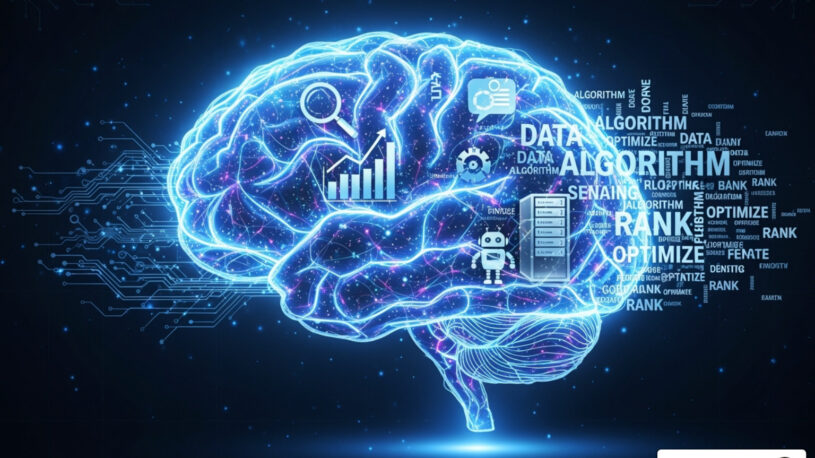

AI vs. Hackers – The Ultimate Cybersecurity Showdown
The AI vs Hacker Arms Race: What You Need to Know
Picture this: while you’re busy running your business, cybercriminals are working overtime to find new ways into your systems. It’s an exhausting thought, isn’t it? But here’s the good news – ai cyber threat prevention is changing the game in our favor.
I’ve seen how implementing AI security transforms a business’s defense posture. The numbers tell a compelling story: AI cybersecurity detects threats 60% faster than traditional methods, giving you precious time to respond before damage occurs. Even better, organizations using AI security automation save an average of $3 million in breach costs – savings that can make or break a small business.
What makes ai cyber threat prevention so effective is its ability to learn what’s normal for your business. Unlike traditional security that triggers alerts for anything unusual (hello, notification fatigue!), AI reduces false positives by understanding your unique patterns and adapting over time.
“The internet has made us conquerors and prisoners simultaneously,” notes a recent cybersecurity research paper. This digital paradox hits small and medium businesses particularly hard – you face the same sophisticated threats as major corporations but with a fraction of their security resources.
The stakes couldn’t be higher. Global cybercrime costs reached a staggering $10.5 trillion in 2023, with attacks becoming more targeted and damaging. What keeps me up at night? About 76% of security professionals believe attackers currently benefit more from AI than defenders do. This technology gap needs closing – fast.
I’m Randy Bryan, founder of tekRESCUE, and I’ve dedicated over a decade to helping businesses implement effective cyber threat prevention strategies. My goal is simple: protect your digital assets while letting you focus on growth rather than constant security concerns.
The technology powering this protection includes machine learning that spots patterns humans might miss, natural language processing to detect suspicious communications, and anomaly detection that flags unusual network behavior. These tools create a formidable defense against modern threats – from zero-day attacks and sophisticated phishing campaigns to malware and even those increasingly convincing deepfakes.
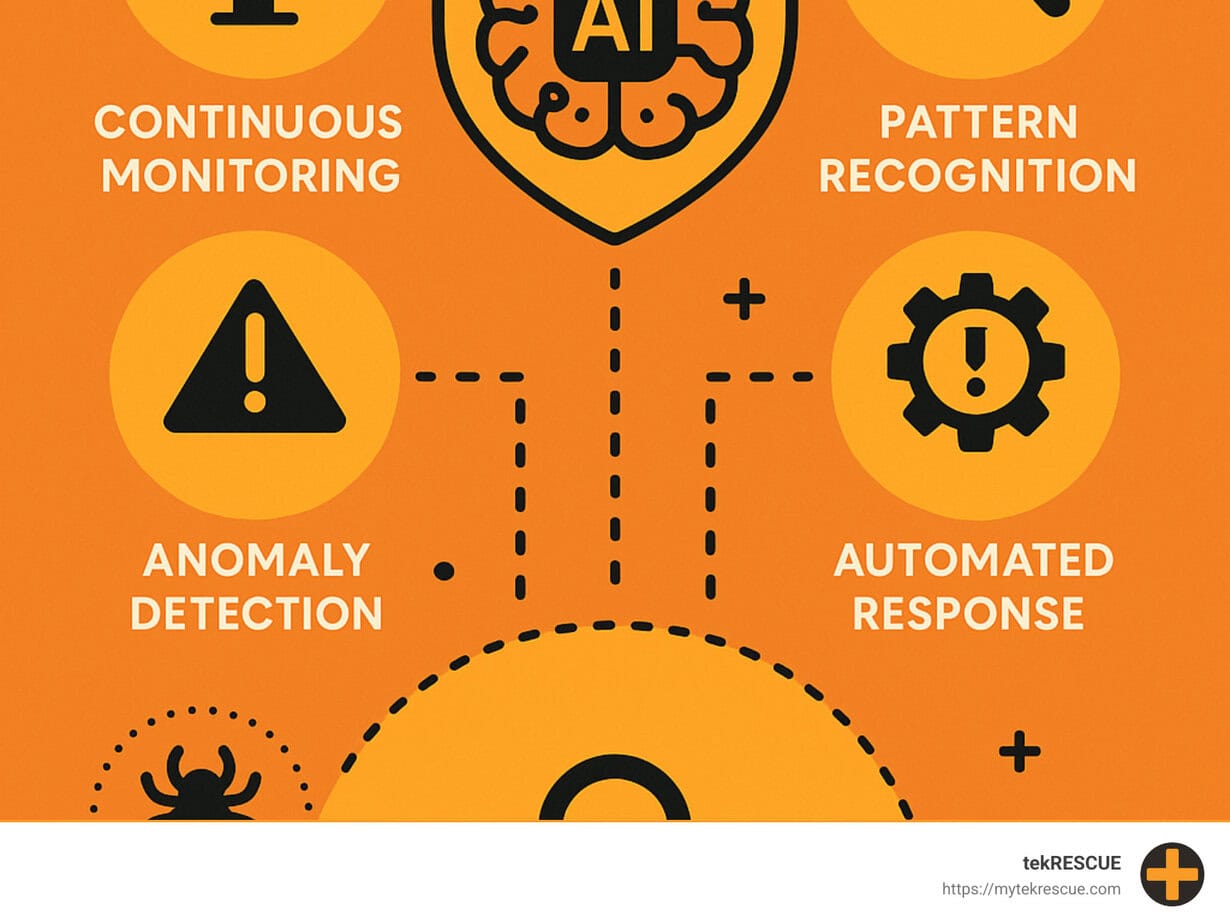
Ai cyber threat prevention glossary:
Inside AI Cyber Threat Prevention
Think of traditional cybersecurity as a castle guard who only knows how to identify intruders based on a list of known criminals. If someone not on the list shows up wearing a disguise, they might walk right through the gate. AI cyber threat prevention, on the other hand, is like having a guard who notices suspicious behavior patterns—regardless of whether the person is on the list—and can make intelligent decisions in real-time about who to let in.
What Is AI Cyber Threat Prevention & How It Outperforms Legacy Defenses
AI cyber threat prevention refers to the use of artificial intelligence and machine learning algorithms to detect, analyze, and respond to cyber threats in ways that traditional security measures cannot. While conventional security tools rely on signature-based detection—looking for known patterns of malicious code—AI security solutions analyze vast amounts of data to identify anomalies and potential threats, even those never seen before.
The limitations of signature-based approaches became evident in the early 2000s, but it wasn’t until the last few years that AI-powered solutions began to address these shortcomings effectively. Today, the difference in effectiveness is remarkable. Organizations with AI-powered threat detection identify cyberattacks 60% faster than traditional methods, and those with fully deployed security AI experience an average reduction of USD 3 million in data breach costs.
We’ve seen how AI can reduce fraud costs by up to 90% by analyzing the risk of each login attempt, and accelerate alert investigations by an average of 55%. This efficiency is game-changing for businesses of all sizes.
As David Corlette, a cybersecurity expert, wisely notes: “AI isn’t useful unless it’s well-designed to incorporate data on the right signals, and unless it’s well-trained.” This highlights something I always tell our clients at tekRESCUE—the quality of AI implementation matters tremendously. We ensure that AI systems are properly configured and trained on relevant data to maximize their effectiveness for businesses across Texas.
The AI Toolbox: ML, Deep Learning, NLP & Anomaly Detection
The power of ai cyber threat prevention comes from a combination of sophisticated technologies working together:
Machine Learning (ML) forms the foundation of AI security. These algorithms analyze historical security data to identify patterns and learn what constitutes normal versus suspicious behavior. The beauty of ML is that it improves over time as it processes more data—like a security guard who gets better at spotting trouble with experience.
Deep Learning takes this a step further. Using neural networks with multiple layers that mimic the human brain, deep learning excels at identifying complex patterns in massive datasets. It’s particularly effective for analyzing images and behavior, catching subtle signs of compromise that would slip past traditional systems.
Natural Language Processing (NLP) is your digital linguist. It allows AI systems to understand and analyze text-based threats such as phishing emails or suspicious communications. NLP can detect subtle linguistic patterns that might indicate someone is trying to trick your employees—like noticing when an email that claims to be from your CEO doesn’t quite sound like them.
Anomaly Detection creates baselines of normal system and user behavior, then flags deviations that might indicate compromise. This is crucial for identifying zero-day threats and insider attacks that signature-based systems would miss. It’s like noticing when someone who normally works 9-to-5 suddenly logs in at 3 AM from another country.
| Feature | Traditional Rule-Based Detection | AI-Driven Detection |
|---|---|---|
| Detection Method | Known signatures and static rules | Behavioral analysis and pattern recognition |
| Zero-Day Threat Detection | Poor – Cannot detect unknown threats | Strong – Can identify anomalous behavior |
| False Positives | High – Limited context awareness | Lower – Learns and improves over time |
| Adaptability | Manual updates required | Self-improving with more data |
| Response Time | Minutes to hours | Seconds to minutes |
| Resource Requirements | Lower initial investment | Higher initial investment, lower long-term cost |
| Threat Intelligence | Static, update-dependent | Dynamic, continuous learning |
“AI systems provide a layer of intelligence that traditional cybersecurity methods lack,” explains a recent industry report. “By automating threat detection processes, AI alleviates the burden on human analysts.” We’ve seen this relief when working with overwhelmed IT teams who can finally focus on strategic initiatives rather than endless alert monitoring.
Stopping Modern Threats: Malware, Phishing, Insider, Zero-Day, Deepfakes
Modern cyber threats have evolved beyond simple viruses and spam. Here’s how ai cyber threat prevention tackles today’s most dangerous attack vectors:
Malware Analysis with AI detects threats by analyzing code behavior rather than just signatures. This means it can identify new malware variants that share behavioral characteristics with known threats, even if their code is completely different. It’s like recognizing a criminal by their actions rather than just their face.
Spear Phishing Defense uses AI to examine email content, sender behavior, and contextual clues to identify sophisticated phishing attempts. It can detect subtle anomalies in communication patterns that might indicate someone is impersonating a trusted contact. We’ve helped clients avoid devastating financial losses by catching highly convincing phishing emails that traditional filters missed.

Insider Threat Detection establishes baselines of normal user behavior, allowing AI to identify when employees access unusual systems or transfer data in suspicious ways. This helps catch both malicious insiders and compromised accounts without creating a culture of distrust. The system simply notices when behavior deviates from established patterns.
Zero-Day Attack Prevention is perhaps the most impressive capability of AI security. By detecting deviations from normal patterns, AI can flag potential zero-day exploits before they cause damage. This is crucial because these attacks exploit previously unknown vulnerabilities for which no patches exist. More info about Zero-Day attacks
Deepfake Fraud Protection has become increasingly important as deepfake technology advances. AI systems are being trained to detect synthetic media by analyzing subtle inconsistencies invisible to the human eye. A recent case from March 2024 highlights this threat: attackers used an AI-generated deepfake of a CEO’s voice to trick an employee into transferring funds. Advanced AI security can detect these synthetic voices by identifying unnatural patterns in audio frequencies.
Automated Incident Response & Real-Time Mitigation
One of the most valuable aspects of ai cyber threat prevention is its ability to not just detect threats but respond to them automatically:
Security Orchestration, Automation and Response (SOAR) platforms use AI to coordinate security tools and automate response workflows. When a threat is detected, the system can immediately isolate affected systems, block malicious IPs, or reset compromised credentials without human intervention. This means protection continues even at 3 AM when your team is asleep.
Autonomous Security Agents continuously monitor networks and endpoints, making decisions about potential threats and taking containment actions in real-time. As one security professional I work with describes it: “Imagine a digital guardian that never sleeps, learns from every attack, and adapts faster than any human could.”
Containment and Remediation happens automatically when threats are detected. AI systems can implement containment strategies to prevent lateral movement through networks—temporarily isolating systems, blocking unusual traffic patterns, or requiring additional authentication for sensitive actions. This automated response can stop an attack before it spreads throughout your organization.
Reduced Alert Fatigue is a benefit I’ve seen transform security teams. By intelligently correlating security events and prioritizing alerts based on risk levels, AI dramatically reduces the number of false positives that security teams must investigate. This addresses a critical problem in cybersecurity—alert fatigue—which often leads to important warnings being missed amid the noise.
Studies show that AI-powered security systems can reduce the time from detection to remediation by up to 60%. For businesses in Texas, especially those without large security teams, this automated response capability can mean the difference between a minor security incident and a devastating breach. More info about Cyber Emergencies
Challenges, Integration & Future Trends
While ai cyber threat prevention offers powerful protection, it’s not without challenges. Understanding these limitations and how to address them is essential for effective implementation.
The Dark Side: False Positives, Model Bias & Adversarial Attacks
Despite its sophistication, AI security isn’t perfect. Even advanced AI systems can generate false positives. Though the rate is typically lower than with traditional systems, you’ll still need processes for efficiently validating alerts. As one security analyst puts it: “AI helps separate the signal from the noise, but human judgment remains essential for interpreting that signal.”
Data poisoning represents another serious concern. Attackers can deliberately feed misleading data to machine learning models during their training phase, causing them to make incorrect decisions later. This “poisoning” can happen if training data isn’t properly secured.
With the rise of large language models in security tools, we’re seeing a new threat emerge: prompt injection attacks. These clever attacks trick AI systems by inserting malicious instructions into seemingly innocuous inputs, potentially bypassing security measures.
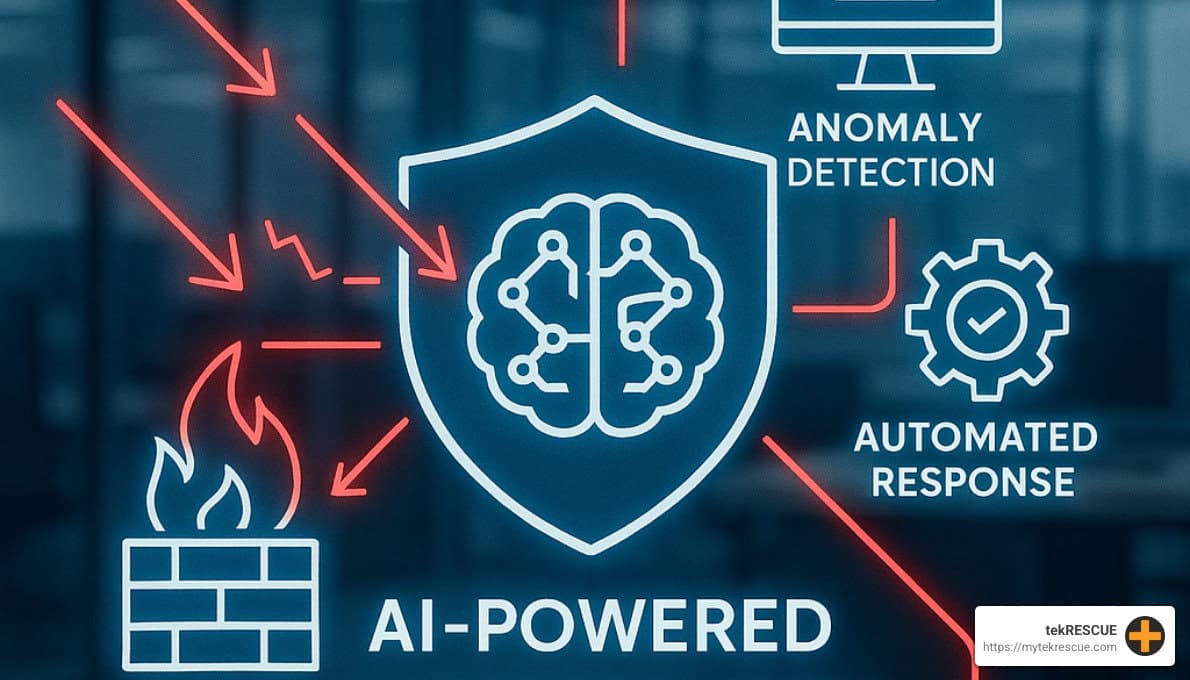
Sophisticated attackers are now studying how AI detection systems work and creating attacks specifically designed to evade them. These adversarial machine learning techniques might involve making subtle modifications to malware code that preserve its functionality while avoiding patterns that AI has been trained to detect. Scientific research on adversarial attacks
Privacy concerns shouldn’t be overlooked either. AI cyber threat prevention systems process vast amounts of data, including potentially sensitive information. Your organization must ensure AI implementations comply with regulations like GDPR and CCPA through data anonymization and proper governance.
“AI is not a factotum and will not be able to handle everything on its own, at least not right now,” notes a cybersecurity research paper. This realistic assessment reminds us that AI is a powerful tool in the security arsenal, but not a complete replacement for human expertise.
Plugging AI Into Your Security Stack Without Breaking It
Successfully integrating AI security tools with existing infrastructure requires careful planning. Modern Security Information and Event Management (SIEM) systems now incorporate AI capabilities or can be integrated with standalone AI tools. This integration allows for centralized monitoring and response across your organization’s security stack.
Most AI security platforms offer APIs that allow them to connect with existing security tools. These connectors enable seamless data flow between systems and coordinated responses to threats, creating a more unified defense.
User and Entity Behavior Analytics (UEBA) tools powered by AI monitor the behavior of users and systems to detect anomalies. They can be integrated with identity management systems to automatically adjust access privileges based on risk assessments, adding an extra layer of protection.
As businesses increasingly operate in hybrid environments, ai cyber threat prevention tools must be able to monitor and protect resources across on-premises systems, private clouds, and public cloud services. This hybrid cloud security approach ensures no gaps in your protection.
The cybersecurity skills shortage is a significant challenge, but AI can help by automating routine tasks and providing guidance to less experienced team members. As one security professional notes: “AI isn’t replacing security analysts—it’s making them more effective by handling the routine so they can focus on the complex.”
For businesses in San Marcos, Kyle, Austin, Dallas, San Antonio, and throughout Texas, tekRESCUE provides expert guidance on integrating AI security solutions with existing infrastructure, ensuring smooth operation and maximum protection.
More info about Cybersecurity Risk Assessment
The Road Ahead: Predictive Defense, Autonomous Agents & Regulations
The future of ai cyber threat prevention is rapidly evolving. Next-generation AI security will move from reactive to truly predictive, identifying potential vulnerabilities before they’re exploited. As one industry expert describes it: “Predictive analytics in AI agents acts as a ‘crystal ball’ to forecast attacks before they occur.”
While generative AI creates new risks, it also offers security benefits. Security teams are using these tools to simulate attacks, generate defense scenarios, and improve threat intelligence sharing through natural language interfaces, turning a potential threat into an advantage.
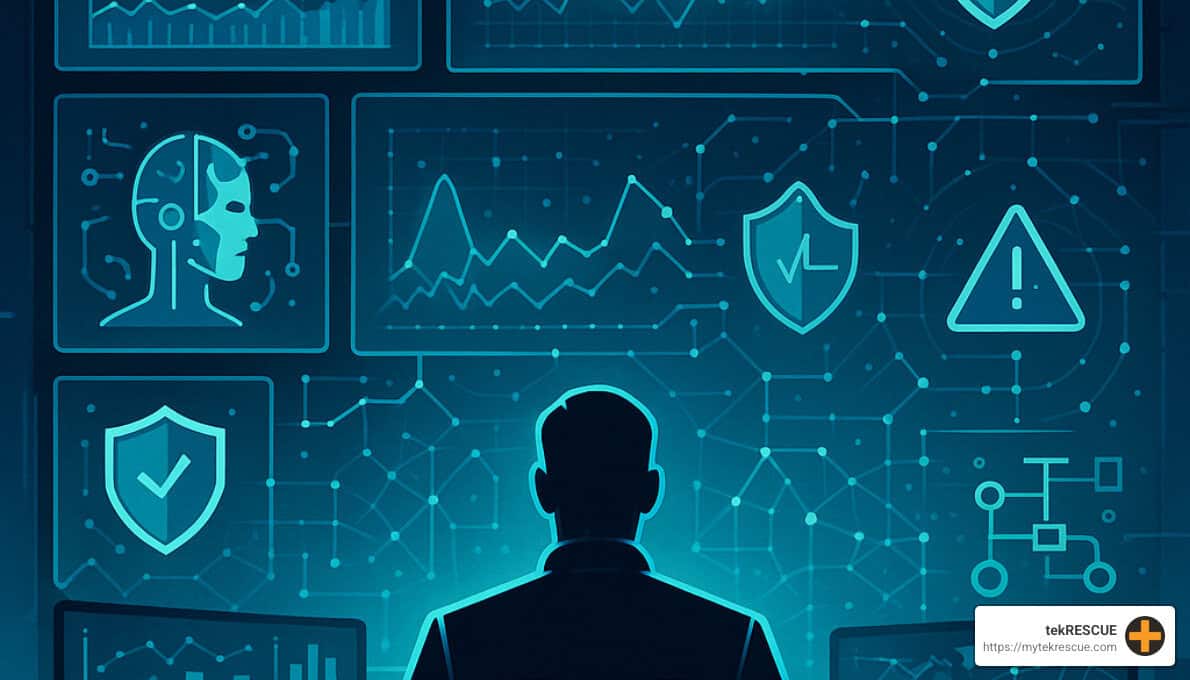
AI-powered deception technology creates convincing decoys (honeypots) that attract attackers, revealing their techniques while keeping real assets safe. These systems adapt based on attacker behavior, creating increasingly realistic traps that help you stay one step ahead.
AI is becoming central to zero-trust security models, continuously verifying users and devices based on behavior rather than relying on perimeter defenses. This approach assumes no entity is trusted by default, regardless of location or network connection, providing more thorough protection.
The regulatory landscape is also evolving. The EU AI Act and similar regulations are establishing frameworks for responsible AI use, including in cybersecurity. CISA (Cybersecurity and Infrastructure Security Agency) has also released guidelines for secure AI implementation that organizations should follow to stay compliant.
The AI cybersecurity market is projected to grow from $24.8 billion in 2024 to $102 billion by 2032, reflecting the increasing importance of these technologies in the security landscape. For businesses in Texas, staying ahead of these trends with expert guidance is essential for maintaining robust security postures.
Conclusion & Strategic Next Steps
The battle between AI defenders and cyber attackers grows more intense each day, with both sides constantly evolving their capabilities. In this high-stakes digital chess match, having the right strategy makes all the difference.
At tekRESCUE, we’ve guided businesses across San Marcos, Kyle, Dallas, San Antonio, and throughout Central Texas in implementing effective ai cyber threat prevention approaches that balance cutting-edge technology with practical business needs. We understand that security isn’t just about having the latest tools—it’s about using them intelligently.
Our approach centers around four key principles that make all the difference:
Adopting a Proactive Mindset means shifting away from simply reacting to threats after they happen. Instead, we help you anticipate and prevent potential attacks before they impact your operations. This forward-thinking approach keeps you a step ahead of cybercriminals.
Human-AI Collaboration creates a powerful partnership where technology and people complement each other perfectly. Your AI systems handle the speed and volume of threat detection, while your team provides the crucial context and judgment that only humans can offer. It’s not about replacing people—it’s about making them more effective.
Continuous Learning ensures your security systems grow smarter over time. Just as your team develops expertise with experience, your AI defenses learn from each new threat they encounter, constantly adapting and improving their protective capabilities.
Strategic Integration means your AI security tools work seamlessly with your existing infrastructure and business processes. Security should strengthen your operations, not disrupt them.

As we look to the future, the businesses that thrive will be those that accept ai cyber threat prevention as a strategic advantage rather than viewing it as just another technical necessity. With cyber attacks becoming both more sophisticated and more frequent, the right AI security implementation provides not just protection but genuine peace of mind.
Think of it this way: you wouldn’t leave your office doors open uped overnight, so why leave your digital assets vulnerable? The difference is that modern cyber threats are far more sophisticated than a simple break-in—they’re more like having professional thieves who can pick locks, disable alarms, and sometimes even make copies of your keys without you noticing.
Ready to strengthen your business’s cyber defenses with AI? Contact tekRESCUE today for a comprehensive security assessment and a customized AI security strategy custom to your specific needs. Our team of experts serves businesses throughout Texas, providing local, hands-on support combined with cutting-edge security expertise. More info about Strategic AI Consulting
As cybersecurity experts often say, “Knowledge is power when facing AI-driven cyber risks.” Let tekRESCUE empower your business with the knowledge and tools to stay ahead in the ultimate cybersecurity showdown. After all, in today’s digital landscape, it’s not a matter of if you’ll face a cyber threat—it’s a matter of when, and how prepared you’ll be when it happens.
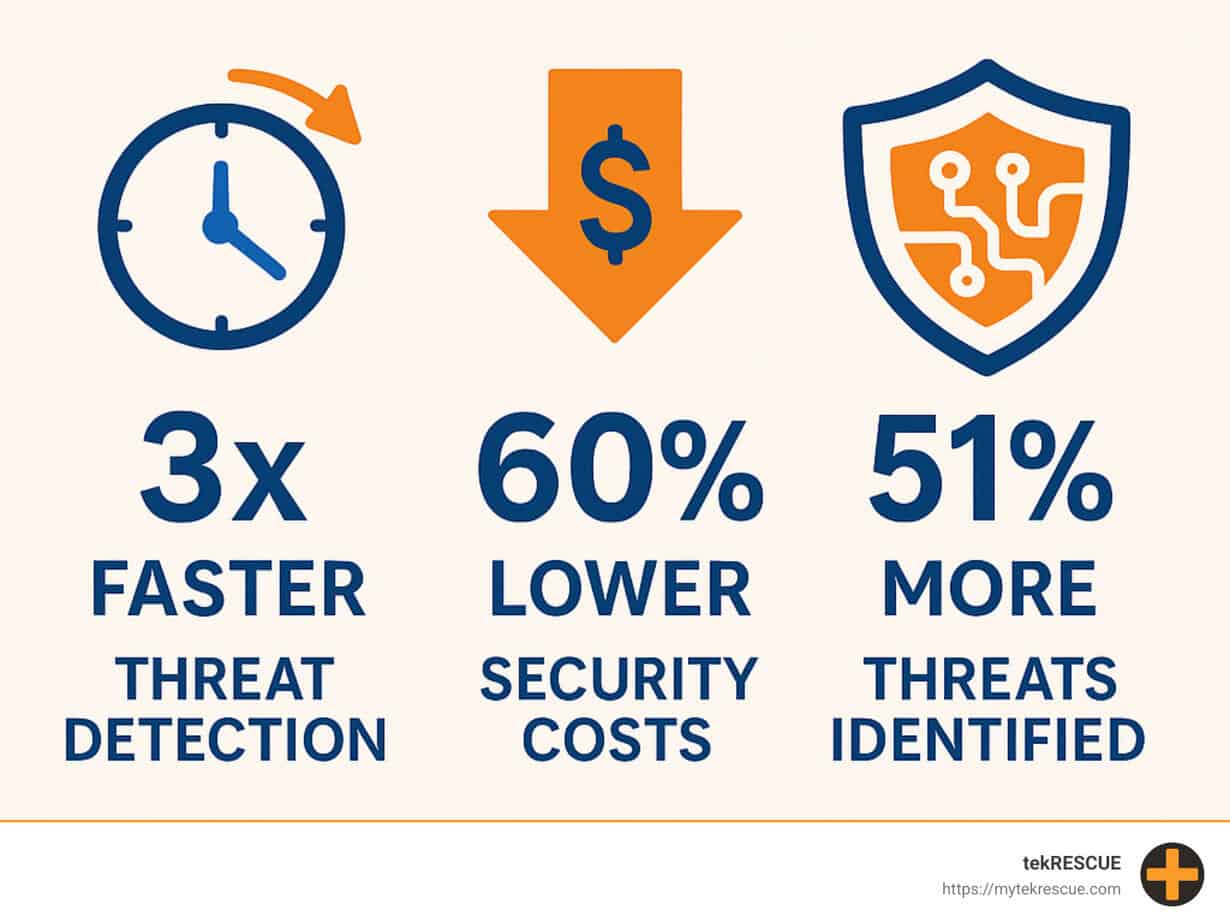
Table of Contents


